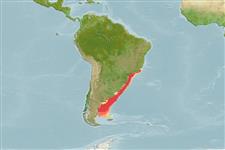Preferred temperature (Ref.
123201): 4.6 - 18.7, mean 8.2 °C (based on 187 cells).
Phylogenetic diversity index (Ref.
82804): PD
50 = 0.5020 [Uniqueness, from 0.5 = low to 2.0 = high].
Bayesian length-weight: a=0.00490 (0.00372 - 0.00644), b=3.13 (3.09 - 3.17), in cm total length, based on LWR estimates for this species (Ref.
93245).
Nível Trófico (Ref.
69278): 2.5 ±0.00 se; based on food items.
Resiliência (Ref.
120179): Médio, tempo mínimo de duplicação da população 1,4 - 4,4 anos (K=0.2-0.3).
Prior r = 0.56, 95% CL = 0.37 - 0.84, Based on 1 data-limited stock assessment.
Fishing Vulnerability (Ref.
59153): Moderate vulnerability (35 of 100).
🛈
Climate Vulnerability (Ref.
125649): Low vulnerability (12 of 100).
🛈
Nutrients (Ref.
124155): Calcium = 188 [80, 437] mg/100g; Iron = 1.24 [0.60, 3.01] mg/100g; Protein = 18.1 [16.9, 19.5] %; Omega3 = 0.767 [0.458, 1.328] g/100g; Selenium = 16.7 [7.4, 37.1] μg/100g; VitaminA = 20 [4, 91] μg/100g; Zinc = 1.34 [0.85, 2.09] mg/100g (wet weight);
